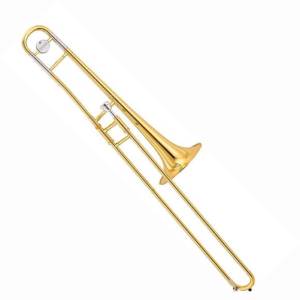Description

The trombone (German: Posaune, Italian, French: trombone) is a musical instrument in the brass family. As with all brass instruments, sound is produced when the player’s vibrating lips cause the air column inside the instrument to vibrate. Nearly all trombones use a telescoping slide mechanism to alter the pitch instead of the valves used by other brass instruments. The valve trombone is an exception, using three valves similar to those on a trumpet, and the superbone has valves and a slide.
The word “trombone” derives from Italian tromba (trumpet) and -one (a suffix meaning “large”), so the name means “large trumpet”. The trombone has a predominantly cylindrical bore like the trumpet, in contrast to the more conical brass instruments like the cornet, the euphonium, and the French horn. The most frequently encountered trombones are the tenor trombone and bass trombone.
These are treated as non-transposing instruments, reading at concert pitch in bass clef, with higher notes sometimes being notated in tenor clef. They are pitched in B♭, an octave below the B♭ trumpet and an octave above the B♭ bass tuba. The once common E♭ alto trombone became less common as improvements in technique extended the upper range of the tenor, but it is regaining popularity for its lighter sonority. In British brass-band music the tenor trombone is treated as a B♭ transposing instrument, written in treble clef, and the alto trombone is written at concert pitch, usually in alto clef.
A person who plays the trombone is called a trombonist or trombone player.
“Trombone” comes from the Italian word tromba (trumpet) plus the suffix -one (large), meaning “large trumpet”.
During the Renaissance, the equivalent English term was “sackbut“. The word first appears in court records in 1495 as “shakbusshe” at about the time King Henry VII married a Portuguese princess who brought musicians with her. “Shakbusshe” is similar to “sacabuche“, attested in Spain as early as 1478. The French equivalent “saqueboute” appears in 1466.[1]
The German “Posaune” long predates the invention of the slide and could refer to a natural trumpet as late as the early fifteenth century.[2]

The sackbut appeared in the 15th century and was used extensively across Europe, declining in most places by the mid to late 17th century. It was used in outdoor events, in concert, and in liturgical settings. Its principal role was as the contratenor part in a dance band.[3] It was also used, along with shawms, in bands sponsored by towns and courts.
Trumpeters and trombonists were employed in German city-states to stand watch in the city towers and herald the arrival of important people to the city, an activity that signified wealth and strength in 16th-century German cities.
These heralding trombonists were often viewed separately from the more skilled trombonists who played in groups such as the alta capella wind ensembles and the first orchestral ensembles, which performed in religious settings such as St Mark’s Basilica in Venice in the early 17th century.[4]
Composers who wrote for trombone during this period include Claudio Monteverdi, Heinrich Schütz, Giovanni Gabrieli and his uncle Andrea Gabrieli. The trombone doubled voice parts in sacred works, but there are also solo pieces written for trombone in the early 17th century.
When the sackbut returned to common use in England in the 18th century, Italian music was so influential that the instrument became known by its Italian name, “trombone”.[5] Its name remained constant in Italy (trombone) and in Germany (Posaune). The 17th-century trombone was built in slightly smaller dimensions than modern trombones, with a bell that was more conical and less flared.
During the later Baroque period, Johann Sebastian Bach and George Frideric Handel used trombones on a few occasions. Bach called for a tromba di tirarsi, which may have been a form of the closely related slide trumpet, to double the cantus firmus in some liturgical cantatas.[6] He also employed a choir of four trombones to double the chorus in three of his cantatas (BWV 2, BWV 21 and BWV 38),[7] and used three trombones and a cornett in the cantata BWV 25.
Handel used it in Samson, in Israel in Egypt, and in the Death March from Saul. All were examples of an oratorio style popular during the early 18th century. Score notations are rare because only a few professional “Stadtpfeiffer” or alta cappella musicians were available. Handel, for instance, had to import trombones to England from a Royal court in Hanover, Germany, to perform one of his larger compositions.[citation needed] Because of the relative scarcity of trombones, their solo parts were generally interchangeable with other instruments.
| Weight | 10 lbs |
|---|---|
| Dimensions | 30 × 10 × 10 in |